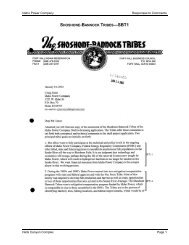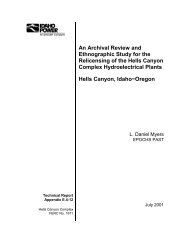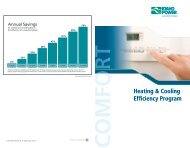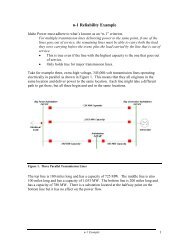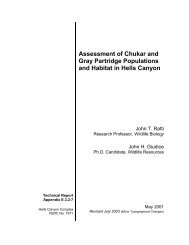Snake River White Sturgeon Conservation Plan ... - Idaho Power
Snake River White Sturgeon Conservation Plan ... - Idaho Power
Snake River White Sturgeon Conservation Plan ... - Idaho Power
You also want an ePaper? Increase the reach of your titles
YUMPU automatically turns print PDFs into web optimized ePapers that Google loves.
<strong>Idaho</strong> <strong>Power</strong> CompanyChapter 4: Conceptual Design for <strong>White</strong> <strong>Sturgeon</strong> Passage Facilitiesfertilization occurs before the demersal, adhesive embryos settle to the substrate (Paragamianet al. 2001 and references within). <strong>White</strong> sturgeon spawn in extremely fast-flowing water, withvelocities exceeding 1.8 m/s considered the most suitable (Parsley et al. 1993, Parsley andBeckman 1994). Researchers have proposed a number of benefits from spawning in fast,turbulent waters. For example, high-velocity flows remove fine sediments from spawning areas,sediments that might otherwise suffocate eggs (Parsley et al. 1993). Also, broadcasting eggs infast, turbulent water may enhance egg viability by dispersing adhesive eggs, thereby preventingclumping and disease. Dispersal probably also reduces egg and larval predation and minimizescompetition among post-larval fish (McCabe and Tracy 1994). In the <strong>Snake</strong> <strong>River</strong>, spawnersfitted with radio transmitters (telemetered fish) were commonly associated with turbulent pools,high-velocity runs, and nearby rapids where eggs were collected (Lepla and Chandler 2001).These telemetered fish used a wide range of depths (2–21 m). Upper velocities approached2.72 m/s in some locations (Lepla and Chandler 2001).<strong>White</strong> sturgeon spawning in the Columbia <strong>River</strong> Basin occurs during spring months (April–July)when water temperatures are between 10 and 18 °C (Parsley et al. 1993, RL & L EnvironmentalServices 1994), with the peak in spawning occurring when temperatures are typically between13 and 15 °C. Generally, the <strong>Snake</strong> <strong>River</strong> reaches have suitable spawning temperatures(10−18 °C) from March through late June, depending on annual spring conditions and thelocation of the reach. Similar to the Columbia <strong>River</strong> observations, Lepla and Chandler (2001)reported that most spawning in the <strong>Snake</strong> <strong>River</strong> occurred when the water temperatures rangedfrom 12 to 16 °C, with mean temperature of 14 °C, which is considered optimal for eggincubation (Wang et al. 1985). The temperature regimes in the <strong>Snake</strong> <strong>River</strong> and the temperaturesof the water in which the majority of eggs were collected (12–16 °C) suggest that peak spawningactivity occurs from mid-March to the end of May in the reaches above the HCC and from lateApril to mid-June in the reaches below the HCC (Lepla and Chandler 2001).2.4. IncubationWang et al. (1985) indicated that a water temperature of 14 °C is optimal for egg incubation, eggmortality increases in temperatures of 18 to 20 °C, and water temperatures beyond 20 °C clearlybecome lethal. Although research has not yet established this conclusion, the lower limit atwhich temperatures become lethal to incubating white sturgeon eggs may be similar to the lowerlimit for other sturgeon species, which is near 6 to 8 °C (Wang et al. 1985). Egg incubationusually lasts 7 to 14 days, depending on water temperature (Bajkov 1949, Wang et al. 1985,Conte et al. 1988). Eggs of white sturgeon are vulnerable to predation because adults broadcastthe eggs and provide no parental protection. Research indicates that several species of fish preyon sturgeon eggs, including northern pike minnow, common carp, largescale sucker, and pricklysculpin (Carl 1936, Patton and Rodman 1969, Scott and Crossman 1973, Wydoski and Whitney1979, Kempinger 1988, Miller and Beckman 1993).Embryonic development of white sturgeon eggs collected in the <strong>Snake</strong> <strong>River</strong> indicated that mostspawning activity occurred within a temperature range of 12 to 16 °C (mean = 14 °C), which isconsidered to be optimal for egg development. Incubating eggs were commonly associated withturbulent pools and runs with mean column velocities ranging from 0.1 to 2.0 m/s and depths of4 to 19 m. Based on temperature regimes in the <strong>Snake</strong> <strong>River</strong> and the timing of most eggHells Canyon Complex Page 5



